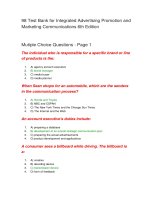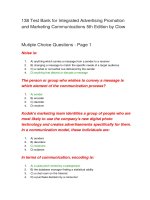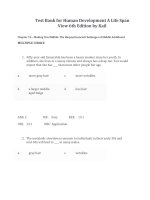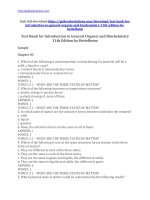Test bank for introduction to maternity and pediatric nursing 6th edition by leifer
Bạn đang xem bản rút gọn của tài liệu. Xem và tải ngay bản đầy đủ của tài liệu tại đây (62.4 KB, 11 trang )
buy this full document at
Leifer: Introduction to Maternity & Pediatric Nursing, 6th Edition
Chapter 01: The Past, Present, and Future
Test Bank
MULTIPLE CHOICE
1. The certified nurse-midwife (CNM) clarifies to the pregnant patient that the CNM’s
scope of practice includes:
a. practice independent from medical supervision.
b. comprehensive prenatal care.
c. attendance at all deliveries.
d. cesarean sections.
ANS: B
The CNM provides comprehensive prenatal and postnatal care and attends uncomplicated
deliveries and ensures that a backup physician is available in case of unforeseen problems.
DIF: Cognitive Level: Comprehension
REF: p. 6
OBJ: 11
TOP: Advance Practice Nursing Roles
KEY: Nursing Process Step: Implementation
MSC: NCLEX: Health Promotion and Maintenance: Prevention and Early Detection of
Disease
2. The medical pioneer who discovered the relationship between the incidence of puerperal
fever and unwashed hands was:
a. Karl Credé.
b. Ignaz Semmelweis.
c. Louis Pasteur.
d. Joseph Lister.
ANS: B
Ignaz Semmelweis deduced that puerperal fever was septic, contagious, and transmitted by
the unwashed hands of physicians and medical students.
DIF: Cognitive Level: Knowledge REF: p. 3
OBJ: 2
TOP: The Past
KEY: Nursing Process Step: N/A
MSC: NCLEX: Safe, Effective Care Environment: Safety and Infection Control
3. A pregnant woman who has recently immigrated to the United States comments to the
nurse, “I am afraid of childbirth. It is so dangerous. I am afraid I will die.” A nursing
response reflecting cultural sensitivity would be:
a. “Maternal mortality in the United States is extremely low.”
b. “Anesthesia is available to relieve pain during labor and childbirth.”
c. “Tell me why you are afraid of childbirth.”
d. “Your condition will be monitored during labor and delivery.”
buy this full document at
Full file at />ANS: C
Asking the patient about her concerns helps promote understanding and individualizes
patient care.
DIF: Cognitive Level: Application REF: p. 7
OBJ: 7
TOP: Cross-Cultural Care
KEY: Nursing Process Step: Implementation
MSC: NCLEX: Psychosocial Integrity: Psychological Adaptation
4. An urban area has been reported to have a high perinatal mortality rate. The nurse
explains that this statistic refers to:
a. maternal and infant deaths per 100,000 live births per year.
b. deaths of fetuses weighing more than 500 g per 10,000 births per year.
c. deaths of infants up to 1 year of age per 1000 live births per year.
d. fetal and neonatal deaths per 1000 live births per year.
ANS: D
The perinatal mortality rate includes both fetal and neonatal deaths per 1000 live births per
year.
DIF:
OBJ:
KEY:
MSC:
5.
a.
b.
c.
d.
Cognitive Level: Comprehension
REF: p. 12, Box 1-6
9
TOP: The Present-Child Care
Nursing Process Step: Implementation
NCLEX: Safe, Effective Care Environment: Coordinated Care
Current maternity practice focuses on:
hospital births for the majority of women.
the traditional family unit.
separation of labor rooms from delivery rooms.
a quality family experience for each patient.
ANS: D
Current maternity practice focuses on a high-quality family experience for all families,
traditional or otherwise.
DIF: Cognitive Level: Comprehension
REF: p. 2
OBJ: 1
TOP: The Present-Maternity Care KEY: Nursing Process Step: N/A
MSC: NCLEX: Health Promotion and Maintenance
6. The individual who advocated the establishment of the Children’s Bureau was:
a. Lillian Wald.
b. Florence Nightingale.
c. Florence Kelly.
d. Clara Barton.
ANS: A
Lillian Wald is credited with suggesting the establishment of a federal Children’s Bureau.
Copyright © 2011 by Saunders, an imprint of Elsevier Inc.
Full file at />DIF: Cognitive Level: Knowledge REF: p. 4
OBJ: 2
TOP: The Past
KEY: Nursing Process Step: Implementation
MSC: NCLEX: Health Promotion and Maintenance: Growth and Development
7.
a.
b.
c.
d.
As a result of research done in the 1930s by the Children’s Bureau:
children with heart problems are now cared for by pediatric cardiologists.
the Child Abuse and Prevention Act was passed.
hot lunch programs were established in many schools.
children’s asylums were founded.
ANS: C
School hot lunch programs were developed as a result of research by the Children’s Bureau
on the effects of economic depression on children.
DIF: Cognitive Level: Knowledge REF: p. 4
OBJ: 4
TOP: The Past
KEY: Nursing Process Step: N/A
MSC: NCLEX: Health Promotion and Maintenance: Coordinated Care
8. The government program implemented to increase the educational exposure of preschool
children is:
a. WIC.
b. Title XIX of Medicaid.
c. The Children’s Charter.
d. Head Start.
ANS: D
Head Start programs were established to increase educational exposure of preschool children.
DIF:
TOP:
KEY:
MSC:
Cognitive Level: Knowledge REF: p. 3
OBJ: 5
Government Influences in Maternity and Pediatric Care
Nursing Process Step: N/A
NCLEX: Health Promotion and Maintenance: Growth and Development
9. Guidelines that define multidisciplinary patient care in terms of expected outcome and
timeframe from different areas of care provision are known as:
a. clinical pathways.
b. nursing outcome criteria.
c. standards of care.
d. nursing care plan.
ANS: A
Clinical pathways, also known as critical pathways or care maps, are collaborative guidelines
that define patient care across disciplines. Expected progress within a specified timeline is
identified.
Copyright © 2011 by Saunders, an imprint of Elsevier Inc.
Full file at />DIF: Cognitive Level: Knowledge REF: p. 12 OBJ: 14
TOP: Health Care Delivery Systems
KEY: Nursing Process Step: N/A
MSC: NCLEX: Safe, Effective Care Environment: Coordinated Care
10. A nursing student has reviewed a hospitalized child’s chart, interviewed her mother, and
collected admission data. The next step in developing a nursing care plan for this child is
to:
a. identify measurable outcomes with a timeline.
b. choose specific nursing interventions for the child.
c. determine appropriate nursing diagnoses.
d. state nursing actions related to the child’s medical diagnosis.
ANS: C
The nurse uses assessment data to select appropriate nursing diagnoses from the NANDA-I
list. Outcomes and interventions are then developed to address the relevant nursing
diagnoses.
DIF:
TOP:
KEY:
MSC:
Cognitive Level: Application REF: p. 11 OBJ: 12
Nursing Process
Nursing Process Step: Nursing Diagnosis
NCLEX: Safe, Effective Care Environment: Coordinated Care
11. A nursing student on an obstetric rotation questions the floor nurse about the definition of
the LVN/LPN scope of practice. The nurse directs the student to contact the:
a. American Nurses Association.
b. State’s board of nursing.
c. Joint Commission.
d. Association of Women’s Health, Obstetric and Neonatal Nurses.
ANS: B
The scope of practice of the LVN/LPN is published by the State’s board of nursing.
DIF: Cognitive Level: Application REF: p. 13 OBJ: 18
TOP: Critical Thinking
KEY: Nursing Process Step: Implementation
MSC: NCLEX: Safe, Effective Care Environment: Coordinated Care
12. In 1884, Karl Credé recommended that:
a. all women should be delivered in a hospital setting.
b. chemical means should be used to combat infection.
c. podalic version be done on all fetuses.
d. silver nitrate be placed in the eyes of newborns.
ANS: D
In 1884, Karl Credé recommended the use of 2% silver nitrate to be placed in the eyes of
newborns to reduce the incidence of blindness. The practice is still current, but uses 1%
silver nitrate.
Copyright © 2011 by Saunders, an imprint of Elsevier Inc.
Full file at />DIF: Cognitive Level: Comprehension
REF: p. 2
OBJ: 2
TOP: Use of Silver Nitrate
KEY: Nursing Process Step: N/A
MSC: NCLEX: Health Promotion and Maintenance: Prevention and Early Detection of
Disease
13. The White House Conference on Children and Youth is held every 10 years to:
a. set criteria for normal growth patterns.
b. examine the number of live births in minority populations.
c. raise money to support well-child clinics in rural areas.
d. promote comprehensive child welfare.
ANS: D
White House Conferences on Children and Youth are held every 10 years to promote
comprehensive child welfare.
DIF: Cognitive Level: Knowledge REF: p. 4
OBJ: 4
TOP: White House Conferences
KEY: Nursing Process Step: N/A
MSC: NCLEX: Health Promotion and Maintenance: Prevention and Early Detection of
Disease
14. Current legislation allows a hospital stay of how many hours for a postpartum patient
who has delivered vaginally without complications?
a. 24
b. 48
c. 36
d. 72
ANS: B
Postpartum patients who deliver vaginally stay in the hospital for an average of 48 hours,
patients who have had a cesarean delivery usually stay 4 days.
DIF: Cognitive Level: Application REF: p. 6
OBJ: 1
TOP: Hospital Terms for Postpartum Patients
KEY: Nursing Process Step: Planning
MSC: NCLEX: Health Promotion and Maintenance: Prevention and Early Detection of
Disease
15. The nurse explains that the clinical pathway or critical pathway improves quality of care
by:
a. listing diagnosis-specific implementations.
b. outlining expected progress with stated timelines.
c. prioritizing effective nursing diagnoses.
d. describing common complications.
ANS: B
Copyright © 2011 by Saunders, an imprint of Elsevier Inc.
Full file at />Critical pathways outline expected progress with stated timelines. Any deviation from those
timelines is called a variance.
DIF: Cognitive Level: Comprehension
REF: p. 12 OBJ: 14
TOP: Critical Pathway
KEY: Nursing Process Step: Implementation
MSC: NCLEX: Safe, Effective Care Environment: Coordinated Care
16. When the patient asks the nurse to explain what is meant by “gene therapy,” the nurse’s
best response would be that gene therapy:
a. can replace missing genes.
b. evaluates the parent’s genes.
c. can change the sex of the fetus.
d. supports the regeneration of defective genes.
ANS: A
Gene therapy can replace missing or defective genes.
DIF: Cognitive Level: Analysis
REF: p. 8
OBJ: 1
TOP: Gene Therapy
KEY: Nursing Process Step: Implementation
MSC: NCLEX: Health Promotion and Maintenance: Prevention and Early Detection of
Disease
17. The nurse clarifies to a patient that diagnosis related groups (DRGs) are designed to
contain medical care costs by:
a. determining payment based on diagnosis.
b. requiring two medical opinions to confirm a diagnosis.
c. organizing HMOs.
d. defining a person who will require hospitalization.
ANS: A
DRGs determine the amount of payment and length of hospital stay based on the diagnosis.
DIF: Cognitive Level: Comprehension
REF: p. 9
OBJ: 10
TOP: DRGs KEY: Nursing Process Step: Implementation
MSC: NCLEX: Safe, Effective Care Environment: Coordinated Care
18. An example of a Nursing Interventions Classification (NIC) intervention is the:
a. patient will ambulate in the hall independently for 10 minutes three times a day.
b. nurse will report temperature elevations to the charge nurse.
c. nurse will offer extra liquids at all meals.
d. patient will express pain relief after massage.
ANS: C
NIC is a guide to nursing actions.
DIF:
Cognitive Level: Application REF: p. 15
OBJ: 10
Copyright © 2011 by Saunders, an imprint of Elsevier Inc.
Full file at />TOP: NICs KEY: Nursing Process Step: N/A
MSC: NCLEX: Safe, Effective Care Environment: Coordinated Care
19. The nurse clarifies to the patient that charting in an electronic health record supports
accurate and comprehensive documentation by requiring:
a. a uniform style of chart.
b. certain responses before allowing the user to progress.
c. documentation reflective of the nursing care plan.
d. a daily audit by the charge nurse.
ANS: B
Comprehensive electronic documentation is ensured by requiring specific input in designated
categories before the user can progress through the system.
DIF: Cognitive Level: Application REF: p. 16 OBJ: 22
TOP: Computer Charting
KEY: Nursing Process Step: Implementation
MSC: NCLEX: Safe, Effective Care Environment: Coordinated Care
20. The nurse reminds family members that the philosophy of family-centered care is to give
them control over their health care decisions. This control is called:
a. empowerment.
b. insight.
c. regulation.
d. organization.
ANS: A
The term “empowerment” refers to the control a family has over its own health care
decisions.
DIF: Cognitive Level: Knowledge REF: p. 2
OBJ: 1
TOP: Empowerment
KEY: Nursing Process Step: Implementation
MSC: NCLEX: Physiological Integrity: Basic Care and Comfort
21. A patient in the prenatal clinic is concerned about losing her job because of her
pregnancy. The nurse instructs her that the Family Medical Leave Act (FMLA) allows an
employee to be absent from work without pay for ______ weeks to recover from
childbirth or care for a sick family member without loss of benefits or pay status.
a. 4
b. 6
c. 10
d. 12
ANS: D
The FMLA allows for employees to leave work for up to 12 weeks to recover from childbirth
or to care for an ill family member without losing benefits or pay status.
Copyright © 2011 by Saunders, an imprint of Elsevier Inc.
Full file at />DIF: Cognitive Level: Knowledge REF: p. 4
OBJ: 5
TOP: FMLA KEY: Nursing Process Step: Implementation
MSC: NCLEX: Psychosocial Integrity: Coping and Adaptation
22. The nurse who is able to adapt health care practices to meet needs of various cultures is
said to be culturally:
a. aware.
b. sensitive.
c. competent.
d. adaptive.
ANS: C
The nurse who is able to adapt health care to meet the needs of various cultures is said to be
culturally competent.
DIF: Cognitive Level: Comprehension
REF: p. 7
OBJ: 7
TOP: Cultural Competency
KEY: Nursing Process Step: N/A
MSC: NCLEX: N/A
23. One of the major advantages to the application of critical thinking is that it results in:
a. problem-free care.
b. limited approaches to care.
c. less need for assessment.
d. problem prevention.
ANS: D
Critical thinking results in problem prevention in designing nursing care.
DIF: Cognitive Level: Application REF: p. 13 OBJ: 19
TOP: Critical Thinking
KEY: Nursing Process Step: N/A
MSC: NCLEX: N/A
MULTIPLE RESPONSE
24. What services does the nurse know that birthing centers are able to provide? Select all
that apply.
a. Prenatal care
b. Labor and delivery services
c. Classes for new mothers
d. Adoption referrals
e. Family planning
ANS: A, B, C, E
Birthing centers are capable of providing full-service obstetric care, classes for new mothers,
and family planning. Birthing centers do not offer adoption services.
Copyright © 2011 by Saunders, an imprint of Elsevier Inc.
Full file at />DIF: Cognitive Level: Analysis
REF: p. 6
OBJ: 10
TOP: Birthing Centers
KEY: Nursing Process Step: Implementation
MSC: NCLEX: Health Promotion and Maintenance: Coordinated Care
25. What developments in the early 20th century encouraged women to seek hospitalization
for childbirth? Select all that apply.
a. Use of specialized obstetric instruments
b. Use of anesthesia
c. Physicians’ closer relationships with hospitals
d. Focus on family-centered care
e. Insurance coverage
ANS: A, B, C
In the early 1900s, the development of specialized obstetric instruments, better modes of
anesthesia, and the physician’s reliance on hospital services were instrumental in bringing
childbirth to the hospital rather than at home.
DIF: Cognitive Level: Analysis
REF: p. 3
OBJ: 10
TOP: Hospitalization for Childbirth KEY: Nursing Process Step: Implementation
MSC: NCLEX: Safe, Effective Care Environment: Safety and Infection Control
26. The nurse points out some non-family–centered policies prevalent in the 1960s. What are
they? Select all that apply.
a. Waiting room for fathers
b. Sedation of mother during labor
c. Delay of reunion of mother and infant
d. Lenient visiting hours
e. Restrictions of visitations by minor children
ANS: A, B, C, E
Hospital policies in the 1960s provided a separate waiting room for fathers while the mother
went through labor in a sedated state. The reunion of mother and infant was delayed for
several hours due to the sedation. Visiting hours were rigid and disallowed the visitation of
minor children.
DIF: Cognitive Level: Comprehension
REF: p. 3
OBJ: 10
TOP: Non-Family–Centered Practices
KEY: Nursing Process Step: Implementation
MSC: NCLEX: Safe, Effective Care Environment: Safety and Infection Control
27. The nurse is aware that there is a legal responsibility to report certain diseases and
conditions to county or state health authorities. Which would be included? Select all that
apply.
a. Tuberculosis
b. Child abuse
c. Industrial accidents
d. Sexually transmitted diseases
Copyright © 2011 by Saunders, an imprint of Elsevier Inc.
Full file at />e. Food-borne infections
ANS: A, B, D, E
The nurse has a legal responsibility to report communicable diseases (such as tuberculosis
and sexually transmitted diseases), food-borne infections, child abuse, and threats of suicide.
DIF:
REF:
TOP:
MSC:
Cognitive Level: Application
p. 5, Legal and Ethical Considerations box
OBJ: 13
Reportable Diseases
KEY: Nursing Process Step: Planning
NCLEX: Safe, Effective Care Environment: Safety and Infection Control
COMPLETION
28. The nurse who is very conscientious about hand hygiene is following the concepts set out
by ____________________ and ____________________.
ANS:
Lister, Pasteur
Pasteur, Lister
Both Lister and Pasteur set out that handwashing could reduce incidence of infection by
cross-contamination.
DIF: Cognitive Level: Application REF: p. 2
OBJ: 2
TOP: Handwashing
KEY: Nursing Process Step: Implementation
MSC: NCLEX: Health Promotion and Maintenance: Safety and Infection Control
29. The first White House Conference on Children and Youth was called by President
______________ ________________.
ANS:
Theodore Roosevelt
Theodore Roosevelt called the first White House Conference in 1909.
DIF: Cognitive Level: Knowledge REF: p. 4
OBJ: 2
TOP: White House Conferences
KEY: Nursing Process Step: N/A
MSC: NCLEX: Health Promotion and Maintenance: Prevention and Early Detection of
Disease
30. The nurse reviewing the specific recovery goals set out on a clinical pathway observed
that two goals were not met by their designated timeline. The nurse records a negative
_____________ for these two goals.
ANS:
variance
Copyright © 2011 by Saunders, an imprint of Elsevier Inc.
Full file at />Using a clinical pathway model with goals and associated timelines, the nurse must record a
negative variance when a timeline is not met and consider a new approach or an extended
timeline.
DIF: Cognitive Level: Application REF: p. 12 OBJ: 14
TOP: Variances
KEY: Nursing Process Step: Evaluation
MSC: NCLEX: Safe, Effective Care Environment: Management of Care
Copyright © 2011 by Saunders, an imprint of Elsevier Inc.









